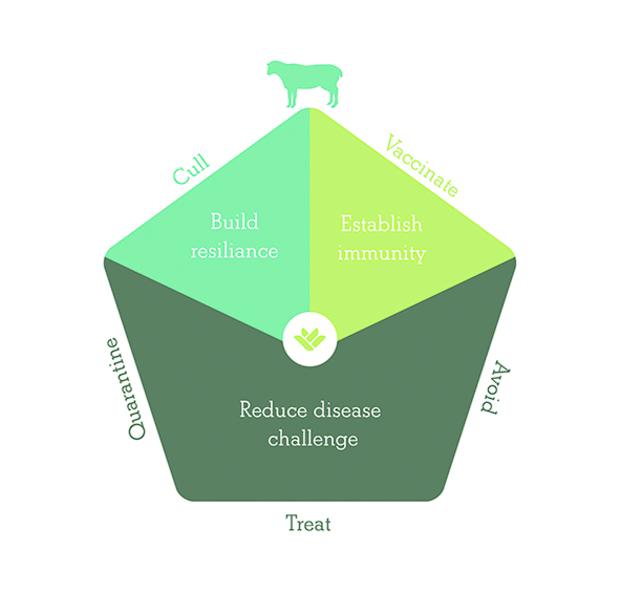Take the first step to stamp out lameness

UK sheep producers are being encouraged to join the march towards stamping out lameness in the national flock when the industry highlights how to take the first step towards better control during July.
Independent experts point out that the later summer months are a great time to start implementing the proven Five-Point Plan for sheep lameness reduction, so there will be plenty of advice available throughout this period to help farmers kick-start their own disease management programme.
“The sheep industry has made real progress with lameness over the last five years but must maintain momentum if it is to meet the Farm Animal Welfare Council (FAWC) target of 2 percent disease incidence in the national flock by 2021,” says Dr Ruth Clements, head of veterinary programmes at farm-based research and development organisation FAI Farms, which developed the Five-Point Plan.

“Implemented correctly and given long term commitment, the Five-Point Plan gives sheep farmers a clear framework for managing lameness effectively because it builds natural disease resilience within the flock, reduces the disease challenge and spread on the farm, and improves flock immunity through vaccination. More widespread adoption on farm will also help the sheep sector cut its use of antibiotics for foot infections and meet new industry targets; a sheep sector task force facilitated by RUMA has already signed up to a 10 percent reduction in antibiotic use by 2020,” Dr Clements adds. Clements says sheep farmers are generally keen to get on top of any flock lameness issues, but sometimes feel helpless and often find it difficult to know how and where to start.

“Now’s the time to start thinking about it seriously,” she says. “Weaning is an ideal time to cull out any ewes with chronic feet, re-set the breeding flock for the new sheep year and build from there.
“Ewes suffering repeated bouts of lameness are a constant source of infection in the flock and make the other control measures ineffective. Use cull tags, spray marks or EID to identify the main offenders and any ewes with chronically misshapen feet. Animals identified as being lame twice in a season should be culled.”
Early treatment of lame sheep & vaccinations
However, early treatment of any lame sheep (ideally within three days of becoming lame) is an important part of the Five-Point Plan, particularly early on in its implementation while there are still a considerable number of lame animals. “The feet of affected sheep should be examined closely to identify any diseases causing the lameness. If in doubt seek veterinary diagnostic advice and then treat the infectious conditions appropriately with antibiotics, even if it is only a mild case.”
If footrot is implicated, vaccination of the whole flock will help reduce the lesions caused by multiple strains of the bacteria Dichelobacter nodosus (most farms have more than two strains), which is present on 97% of farms1 and a year-round threat. On-going vaccination, timed in anticipation of high disease risk times (such as warm, wet underfoot conditions and at housing) on the farm, will also help prevent future problems and reduce antibiotic usage in future years.
Take prevenatative action
Dr Clements adds that further preventative parts of the plan include quarantine of any incoming animals and avoiding spreading disease when sheep are gathered and handled.
She adds that incoming sheep are a potential source of strains of bacteria and are therefore a big risk to sheep already on the farm.
“Make sure you buy sheep carefully (ask your stock supplier if they are following the Five-Point Plan) and do not accept lame animals or any with misshapen feet. Quarantine the incomers for at least four weeks, vaccinating and footbathing them on arrival. Turn every sheep to look for early footrot or CODD and treat any clinical cases as soon as possible.”
Finally, reduce the potential disease challenge from the farm environment; remember that footrot and scald spread from sheep to sheep. “The bacteria that cause most of the lameness problems in the UK spread well in wet, soiled sheep handling and field areas and can survive on pasture for up to two weeks. It is therefore important to spread lime, or use gravel or wood chip, in any poached or heavy traffic areas, such as around feed or water troughs,” Dr Clements says.
On farm advisors at the NSA Sheep Event and Royal Welsh Show
Farmers looking for practical advice on how to take the first step towards reducing sheep lameness in their own flock will be able to talk to on farm advisers at the NSA Sheep Event (July 18) in Malvern and the Royal Welsh Show (July 22-26) in Builth Wells.
During July and August and beyond, sheep producers should ask their vet or SQP at their local animal health product supplier for guidance and support with implementing the Five-Point Plan.
This article was first published in Farmers Guardian on 28th June 2018. The Five-Point Plan was originally developed by FAI Farms.